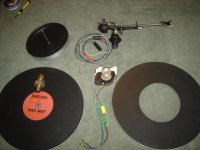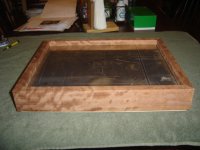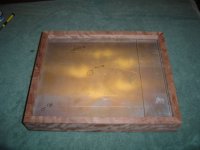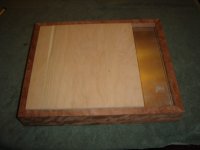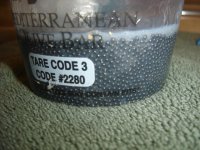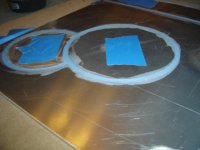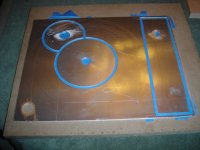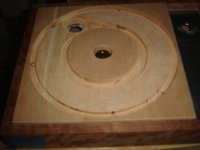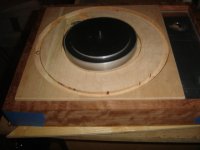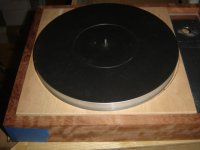The time has come to redo my butcherd Ariston Audio RD80. In my youth, I had this great idea of improving the original design and ended up messing it up. Recently I did get it to work quite well when I built the Simplistic JFET RIAA. The problem is that the Simplistic RIAA FAR outclasses the table by many orders of magnitude. Hence, my decision to rebuild it.
My goals for the project are:
This is an interim project. I plan to experiment with materials in this build so I can build my Super Table at some point in the future. I want to keep the costs within reason for that reason.
Re-use bearing, platter and AC motor. I have the Magnapan tonearm with its slightly off mounting dimension so I would build it for that arm, but yet have the plinth compact enough to play with arms like the Nanook or Schroeder in 12" versions. Size is also important later when I want to externalize the motor.
I have decided to forego the suspension and go the route of absorbing materials and mass.
An aluminum plate will be sandwiched between instrument grade wood and a cast Silicone / Leadshot composit mass cast underneath. I hope the drawings and picts explain the ideas.
The tonearm board isn't shown but will be made of instrument grade curly maple.
Despite having no suspension, energy dissapation and absorbtion will be important in the design. The plinth, bearing, and toenarm will each have their own masses which are decoupled from each other. The mass for each will be significant enough to sink the energy.
I am very open to ideas, thoughts and experience you may have had building a table. I appreciate all comments both positive and negative in that regard.
My goals for the project are:
This is an interim project. I plan to experiment with materials in this build so I can build my Super Table at some point in the future. I want to keep the costs within reason for that reason.
Re-use bearing, platter and AC motor. I have the Magnapan tonearm with its slightly off mounting dimension so I would build it for that arm, but yet have the plinth compact enough to play with arms like the Nanook or Schroeder in 12" versions. Size is also important later when I want to externalize the motor.
I have decided to forego the suspension and go the route of absorbing materials and mass.
An aluminum plate will be sandwiched between instrument grade wood and a cast Silicone / Leadshot composit mass cast underneath. I hope the drawings and picts explain the ideas.
The tonearm board isn't shown but will be made of instrument grade curly maple.
Despite having no suspension, energy dissapation and absorbtion will be important in the design. The plinth, bearing, and toenarm will each have their own masses which are decoupled from each other. The mass for each will be significant enough to sink the energy.
I am very open to ideas, thoughts and experience you may have had building a table. I appreciate all comments both positive and negative in that regard.
Attachments
looks good...
thanks for considering the "Nanook" arm🙂...
it does not belong in the same paragraph as a Schroeder, or similar. My "219" is an easy to make arm using easy to find parts, and I think it competes nicely with my SME 309. I have no idea how it would compare to a a truly excellent design.
Think of my "219" as more of an upgraded or modified Altmann tonearm. About as simple as you can get.
Your plinth design looks great. The stock Ariston plinths are terrible. On a RD11, they are pressboard veneered with hardwood. I must say that if Linn LP12 tables are similar (never had one apart), then I'd consider them a rip-off.
I look forward to your progress.
thanks for considering the "Nanook" arm🙂...
it does not belong in the same paragraph as a Schroeder, or similar. My "219" is an easy to make arm using easy to find parts, and I think it competes nicely with my SME 309. I have no idea how it would compare to a a truly excellent design.
Think of my "219" as more of an upgraded or modified Altmann tonearm. About as simple as you can get.
Your plinth design looks great. The stock Ariston plinths are terrible. On a RD11, they are pressboard veneered with hardwood. I must say that if Linn LP12 tables are similar (never had one apart), then I'd consider them a rip-off.
I look forward to your progress.
Nanook, your arm is of similar concept to the Magnepan arm I have as well. Simplicity rules if done right so don't humble yourself too much.
I haven't heard either the Shroeder or your arm but I would like to make both.
Its cold out so had to take a break from the woodshop. Cutting aluminum with a router is messy.
I haven't heard either the Shroeder or your arm but I would like to make both.
Its cold out so had to take a break from the woodshop. Cutting aluminum with a router is messy.
The time has come to redo my butcherd Ariston Audio RD80. In my youth, I had this great idea of improving the original design and ended up messing it up. Recently I did get it to work quite well when I built the Simplistic JFET RIAA. The problem is that the Simplistic RIAA FAR outclasses the table by many orders of magnitude. Hence, my decision to rebuild it.
My goals for the project are:
This is an interim project. I plan to experiment with materials in this build so I can build my Super Table at some point in the future. I want to keep the costs within reason for that reason.
Re-use bearing, platter and AC motor. I have the Magnapan tonearm with its slightly off mounting dimension so I would build it for that arm, but yet have the plinth compact enough to play with arms like the Nanook or Schroeder in 12" versions. Size is also important later when I want to externalize the motor.
I have decided to forego the suspension and go the route of absorbing materials and mass.
An aluminum plate will be sandwiched between instrument grade wood and a cast Silicone / Leadshot composit mass cast underneath. I hope the drawings and picts explain the ideas.
The tonearm board isn't shown but will be made of instrument grade curly maple.
Despite having no suspension, energy dissapation and absorbtion will be important in the design. The plinth, bearing, and toenarm will each have their own masses which are decoupled from each other. The mass for each will be significant enough to sink the energy.
I am very open to ideas, thoughts and experience you may have had building a table. I appreciate all comments both positive and negative in that regard.
Hi,
considering that you aim for a relatively budget project,you can use a plexiglass tube,for the bearing and platter,circa 120 mm diameter,and a height of 100 mm.It must be "capped",both ends.You can fill the tube with quartz sand or acrylic mastic,though a 50/50 mixture of both,will work wonders,for isolation.You can use some nice cones on the underside,improving immunity from feedback.
For the tonearm base,and motor pod use the same technique ,though a smaller tube 80 mm,and the relative height would be fine.You can mount them on a skeletal base,platter and arm,and let the motor pod,be where it fits best.
B.L.
B.L. I did think about using sand and still may. I have about 6 liters of castable silicone from a project I had several years ago. It is the stuff that simulates skin and is used by costume designers. It is stable enough not to flow over time but makes wonderfully dead material when mixed with lead shot. I can combine that with a sand pocket to further improve sound absorbtion.
The stock Ariston plinths are terrible. On a RD11, they are pressboard veneered with hardwood. I must say that if Linn LP12 tables are similar (never had one apart), then I'd consider them a rip-off.
Yup, Linn even copied the sub-chassis shape. The plinths are solid wood though, and stiff, especially the later "corner braced" ones.
jeff
Jeff,
I was referring to the plinths in particular. The RD11 is very cheap, made of hardboard or similar and veneered. The one I (still) have here is going back the way it is. I've bought some nice teak to make a good plinth. I may re-make the original Ariston using BB ply, and veneer it, just because the stock Ariston one is so terrible, I'd feel bad giving it back to Moray's friend knowing what it is made of.
I was referring to the plinths in particular. The RD11 is very cheap, made of hardboard or similar and veneered. The one I (still) have here is going back the way it is. I've bought some nice teak to make a good plinth. I may re-make the original Ariston using BB ply, and veneer it, just because the stock Ariston one is so terrible, I'd feel bad giving it back to Moray's friend knowing what it is made of.
Ok, here is the aluminum sheet for the top plate, now routed out. You can see how the bearing plate, motor mount and tonearm board will be decoupled from each other. The second photo shows the gaps being filled with silicone. The final picture is of the silicone mixed with lead shot.
When I am ready, I will make a mold on the bottom side of the plate to pour each of the masses needed in-situ. They will be seperated by a gap which corresponds to the routed passages. The bearing and tonearm masses will have a cavity for sand as was sugested above.
When I am ready, I will make a mold on the bottom side of the plate to pour each of the masses needed in-situ. They will be seperated by a gap which corresponds to the routed passages. The bearing and tonearm masses will have a cavity for sand as was sugested above.
Attachments
SGregory....looks good.
but a couple of thoughts.
Idlers seem to do well with massive plinths, but the consensus is that belt drives sound better on low mass plinths (therefore less stored energy ) or hugely massive ones that basically become energy sinks. Had you considered an ultra lightweight top plate/plinth?
Much has been written concerning Linn type tables and light-weight plinths.
but a couple of thoughts.
Idlers seem to do well with massive plinths, but the consensus is that belt drives sound better on low mass plinths (therefore less stored energy ) or hugely massive ones that basically become energy sinks. Had you considered an ultra lightweight top plate/plinth?
Much has been written concerning Linn type tables and light-weight plinths.
I have one of these tts, so I'm watching your progress with interest. Fwiw, when I tricked about with mine, a DIY version of a naim armageddon supply for the motor made a large improvement. I'd strongly consider it if I were you.....
Lovely work so far btw. Are you going to mount the motor in a separate pod?
Fran
Lovely work so far btw. Are you going to mount the motor in a separate pod?
Fran
I am interested in the supply. I haven't found anything about it yet but have not searched hard. Does it still use the ac motor? I have thought of putting a maxon dc motor on it in the future.
For the intitial build, I will be using the same inner platter belt drive. The motor mount will be isolated from the main plinth by a silicone filled gap. The maxon or future motor will be by seperate pod. As will the 12" arms I want to try building.
How is your Shroeder doing Fran?
As far as an ultralight plinth, I had thought about it and did a little reading on the Linn concepts. I went with the heavily damped mass approach as it made more sense to me when trying to control the noise floor and bearing noise. I am stuck using the two piece platter that was original as I don't have another bearing to play with. It is a press on shaft that I couldn't get to move and I didn't want to destroy it.
For the intitial build, I will be using the same inner platter belt drive. The motor mount will be isolated from the main plinth by a silicone filled gap. The maxon or future motor will be by seperate pod. As will the 12" arms I want to try building.
How is your Shroeder doing Fran?
As far as an ultralight plinth, I had thought about it and did a little reading on the Linn concepts. I went with the heavily damped mass approach as it made more sense to me when trying to control the noise floor and bearing noise. I am stuck using the two piece platter that was original as I don't have another bearing to play with. It is a press on shaft that I couldn't get to move and I didn't want to destroy it.
Believe it or not, The RD-80 basically has that circuit in it minus the 2:1 xfmr. It also has a 0.01uF snubber across the mains.
Think it would be wise to use a similar idea and drop from 120V to 60V?
Think it would be wise to use a similar idea and drop from 120V to 60V?
The 90deg is there on all AC TT. I would use a 1:1. The isolation is the goal. Best primary to secondary isolation comes from R-Core which has less capacitance from all others since its windings are totally split on two isolated bobbins. Then is EI, last is toroid.
Finding a 500VA R-core will be a real treat in this country. EI I have somewhere.
I figured that the Vahallia and the other controller listed in the pinkfish site shifted the phase of the second winding but wasn't sure how as it looked to be more complex than the simple circuit that was replacing them or what came in mine.
I figured that the Vahallia and the other controller listed in the pinkfish site shifted the phase of the second winding but wasn't sure how as it looked to be more complex than the simple circuit that was replacing them or what came in mine.
Don't let my dogs know that, They lost those a long time ago ;-)
I'll have an external motor soon enough. May not have that fancy controller though.
I'll have an external motor soon enough. May not have that fancy controller though.
Top Plate
Had an hour or so to play in the shop.
Here is the plinth top plate viewed from underneath. It is routed to create a relief for the bearing plate and motor plate.
The second photo is to top of the top plate which is relieved to accept the motor pulley, inner platter and outer platter.
The inner platter installed
and finally with the outer platter.
The platter sits into the grooves and mantains a 1/8" clearance to the top plate. The wood will be epoxied and screwed to the aluminum plate for strength and rigidity. I can rigidly couple the bearing plate to the wood as well if need be.
Based on suggestions previously, I am now contempating using a "super light and rigid" approach vs. the super mass. The chassis is allready built super rigid. I do want to dampen the bearing, the question is how much weight to cast underneth the bearing plate. The other decision I have to make is what wood to use for the tonearm plate. I cave Leopard Wood, Curly Maple, Wenge, Regular Maple, Cherry, Oak, and I think some Cocobola. I also have a little extra wavy acuna like the chasis is made from. Any thoughts for a starter?
Had an hour or so to play in the shop.
Here is the plinth top plate viewed from underneath. It is routed to create a relief for the bearing plate and motor plate.
The second photo is to top of the top plate which is relieved to accept the motor pulley, inner platter and outer platter.
The inner platter installed
and finally with the outer platter.
The platter sits into the grooves and mantains a 1/8" clearance to the top plate. The wood will be epoxied and screwed to the aluminum plate for strength and rigidity. I can rigidly couple the bearing plate to the wood as well if need be.
Based on suggestions previously, I am now contempating using a "super light and rigid" approach vs. the super mass. The chassis is allready built super rigid. I do want to dampen the bearing, the question is how much weight to cast underneth the bearing plate. The other decision I have to make is what wood to use for the tonearm plate. I cave Leopard Wood, Curly Maple, Wenge, Regular Maple, Cherry, Oak, and I think some Cocobola. I also have a little extra wavy acuna like the chasis is made from. Any thoughts for a starter?
Attachments
I also have a little extra wavy acuna like the chasis is made from. Any thoughts for a starter?
No idea, but I'd start with the acuna cause it looks really nice.
jeff
- Status
- Not open for further replies.
- Home
- Source & Line
- Analogue Source
- "The Phoenix" an Ariston Audio RD80 TT Rebuild
